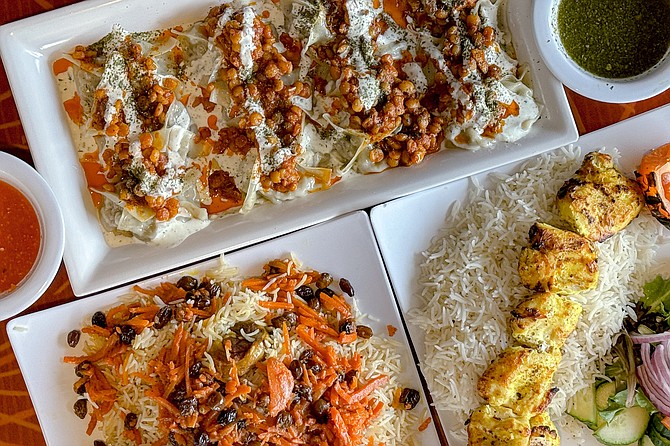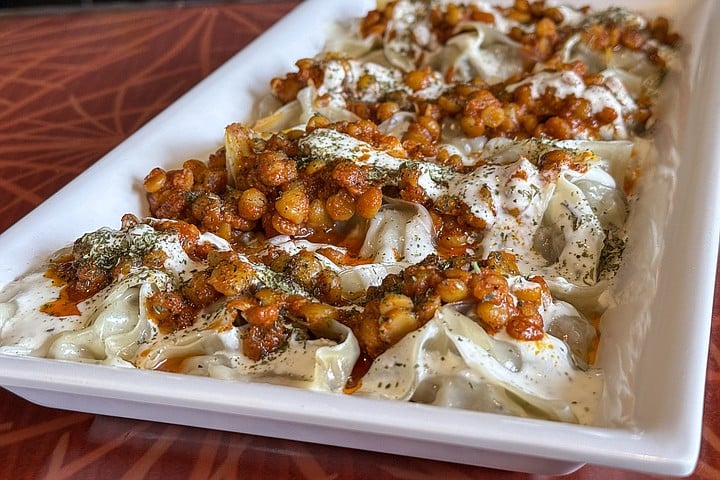 Facebook
Facebook
 X
X
 Instagram
Instagram
 TikTok
TikTok
 Youtube
Youtube

When it’s too much a challenge to find parking on Convoy, I’ve learned that if you drift west across the 805, you can find a smaller, yet no less diverse cluster of restaurants along Clairemont Mesa Boulevard. There you may choose among Cuban, Korean, Thai, Greek, and Japanese cuisines; and for the past several months, food traditional to Afghanistan.
Afghani Food International Market & Restaurant opened this fall, and though its name sounds handed down from the central office of a global conglomerate, it’s a local, family-owned business that leans a little more restaurant than market.

That said, I would suggest exploring the retail foods packed into coolers that span the entire left wall of the spacious dining room, if only for insights into the sort of products Afghan expats might wish to find in a grocery store. There are loads of nuts (I spotted walnuts, pistachios, almonds, and black pine nuts); a choice of dried apricots including chapamamak (which are twisted and dried on the tree; and packs of oleaster, a wild relative of the olive.
Most fascinating are traditionally Afghan ingredients including lumps of the unrefined sugar gur, and dehydrated yogurt balls called quroot. But most tempting would be the array of sweets: ranging from about $8 to $10 a package, these include both ginger and sesame candies, sugar frosted almonds called naqul, and almond cookies called kolcha badami. These are a sort of shortbread cookies, typically flavored with cardamom, and nice for dipping in coffee or tea.

Of course, there’s more to be gleaned about Afghan cuisine by sitting down to a meal. For example, you can tell without having to brush up on your geography that Afghanistan sits roughly between India and the Middle East. So, the menu features the likes of tikka kebab, naan flatbread, and basmati rice, while also offering gyros, chicken shawarma, and falafel.
That’s not to say these come off the same as you’ll find in corresponding restaurants. The tikka here ($19 lamb, $18 beef, or $17 chicken) is far mellower than any Indian version I’ve tried, for example. And then there’s Afghanistan’s national dish, quabli palaow ($19). It’s a lamb shank and rice dish quite similar to the Iraqi national dish, quzi. Both dishes feature lamb, rice, and raisins, but the where quabili differs most is featuring plenty of a common ingredient actually thought to have originated in the vicinity of Afghanistan: carrot.
Caramelized, shredded carrots conspire with black and golden raisins to sweeten the lamb and rice dish — it might have proven too sweet for me had it not been served with a pair of spicy sauces. Whether red or green, these sauces complete the quabli the way salsas complete tacos. I might have avoided making a direct Afghan/Mexican comparison, except two of the restaurants more popular appetizers are billed as “Afghani quesadillas”. Actually, these are Afghan favorites made with flatbread rather than tortilla. They’re called and kachalo ($15) and bolani ($16), the first stuffed with mashed potatoes, the second with a chive-like Afghan leek called gandana.

Still, I’ve saved my favorite for last: a shareable platter of mantu dumplings ($18 for twelve). The delicate, steamed dumplings are filled with a stew of minced beef and onions, which make them similar to any number of dumplings served around the world. Less common would be how they’re served: beneath a drizzle of sour cream and a dusting of dried mint, then finished with lentils that have been stewed in olive oil and tomatoes.
Let this dish be the starting point to exploring Afghani Food International Market & Restaurant. You may always fall back on pizza or burgers (both also on the menu!), but especially if you started out looking for something interesting to eat on Convoy, you’ll embrace the opportunity to try something new.


When it’s too much a challenge to find parking on Convoy, I’ve learned that if you drift west across the 805, you can find a smaller, yet no less diverse cluster of restaurants along Clairemont Mesa Boulevard. There you may choose among Cuban, Korean, Thai, Greek, and Japanese cuisines; and for the past several months, food traditional to Afghanistan.
Afghani Food International Market & Restaurant opened this fall, and though its name sounds handed down from the central office of a global conglomerate, it’s a local, family-owned business that leans a little more restaurant than market.

That said, I would suggest exploring the retail foods packed into coolers that span the entire left wall of the spacious dining room, if only for insights into the sort of products Afghan expats might wish to find in a grocery store. There are loads of nuts (I spotted walnuts, pistachios, almonds, and black pine nuts); a choice of dried apricots including chapamamak (which are twisted and dried on the tree; and packs of oleaster, a wild relative of the olive.
Most fascinating are traditionally Afghan ingredients including lumps of the unrefined sugar gur, and dehydrated yogurt balls called quroot. But most tempting would be the array of sweets: ranging from about $8 to $10 a package, these include both ginger and sesame candies, sugar frosted almonds called naqul, and almond cookies called kolcha badami. These are a sort of shortbread cookies, typically flavored with cardamom, and nice for dipping in coffee or tea.

Of course, there’s more to be gleaned about Afghan cuisine by sitting down to a meal. For example, you can tell without having to brush up on your geography that Afghanistan sits roughly between India and the Middle East. So, the menu features the likes of tikka kebab, naan flatbread, and basmati rice, while also offering gyros, chicken shawarma, and falafel.
That’s not to say these come off the same as you’ll find in corresponding restaurants. The tikka here ($19 lamb, $18 beef, or $17 chicken) is far mellower than any Indian version I’ve tried, for example. And then there’s Afghanistan’s national dish, quabli palaow ($19). It’s a lamb shank and rice dish quite similar to the Iraqi national dish, quzi. Both dishes feature lamb, rice, and raisins, but the where quabili differs most is featuring plenty of a common ingredient actually thought to have originated in the vicinity of Afghanistan: carrot.
Caramelized, shredded carrots conspire with black and golden raisins to sweeten the lamb and rice dish — it might have proven too sweet for me had it not been served with a pair of spicy sauces. Whether red or green, these sauces complete the quabli the way salsas complete tacos. I might have avoided making a direct Afghan/Mexican comparison, except two of the restaurants more popular appetizers are billed as “Afghani quesadillas”. Actually, these are Afghan favorites made with flatbread rather than tortilla. They’re called and kachalo ($15) and bolani ($16), the first stuffed with mashed potatoes, the second with a chive-like Afghan leek called gandana.

Still, I’ve saved my favorite for last: a shareable platter of mantu dumplings ($18 for twelve). The delicate, steamed dumplings are filled with a stew of minced beef and onions, which make them similar to any number of dumplings served around the world. Less common would be how they’re served: beneath a drizzle of sour cream and a dusting of dried mint, then finished with lentils that have been stewed in olive oil and tomatoes.
Let this dish be the starting point to exploring Afghani Food International Market & Restaurant. You may always fall back on pizza or burgers (both also on the menu!), but especially if you started out looking for something interesting to eat on Convoy, you’ll embrace the opportunity to try something new.
Comments